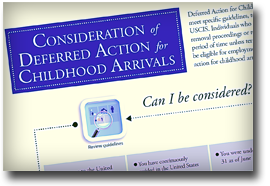The concept that "the devil is in the details" sounds passive on examination; it's as if someone sighs and says: "Yes, that is the way of the world."
But I am convinced that in the latest amnesty (aka, Deferred Action for Childhood Arrivals) the devil has created the details. In other words, parts of the program have been deliberately designed to quietly expand the number of eligibles beyond what might be expected otherwise.

Let's take the variable of the alien's age.
Often, in immigration law, certain groups of alien children are given benefits denied to alien adults, and children are routinely defined as non-married people under the age of 21. Once they pass their 21st birthday or marry, they, in the terminology of the immigration bar, "age out" of eligibility, though immigration lawyers sometimes can wiggle out of that one, as we noted in a blog last year.
In other words, Congress provides a particular benefit to some alien children, but it operates only on a passing basis; once an alien gets married or comes of age the benefit goes away. A sensible arrangement, generally.
But the factor of age plays quite differently in DACA. If you were eligible for the program on June 15, 2012, in terms of age, you stay eligible. You never get too old.
But if you were not eligible on June 15, because you had not yet reached your 15th birthday, you can become eligible when you subsequently reach 15. In other words, aliens cannot "age out" of the program, but they can "age in". Or, heads you win, tails I lose.
Similarly, even though you have never seen the inside of a schoolroom a single day in your entire life, and are otherwise eligible for DACA, you can meet the "education/military" requirement of the program simple by enrolling in an educational institution the day before you apply for amnesty. The education requirement need not have been met on June 15, 2012, as we spelled out in an earlier blog.
My sense is that this is not happenstance; it is quite deliberate. These nuances, not yet discussed in these terms anywhere else to my knowledge, are shrewdly crafted, against a backdrop of detailed knowledge of how such programs have operated in the past.
The big amnesty program of the 1980s, authorized by Congress in the Immigration Reform and Control Act of 1986 (IRCA), created several different populations to be amnestied, but all were fixed as of the effective date of the law; there were no additions to the eligible population in later years. So the eligible population could not expand, it could only shrink through death, departure from the country, or entrance into legal status.
DACA is, to some extent, a rolling amnesty. The eligible population can shrink (as with IRCA), but it can also expand as people pass their 15th birthdays or enroll in school. This is the significant difference between the two programs.
For a full set of DACA eligibility rules, see here.
